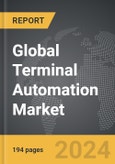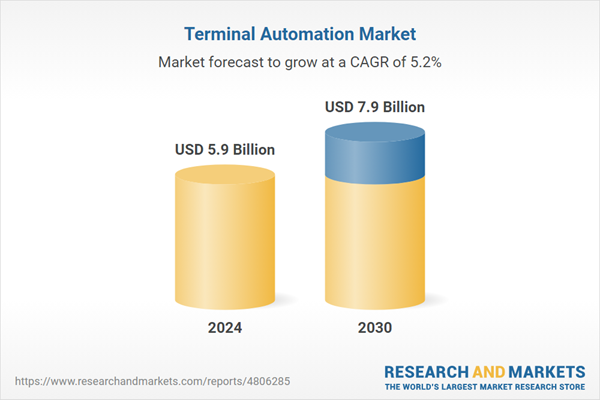Global Terminal Automation Market - Key Trends and Drivers Summarized
What Is Terminal Automation and Why Is It Essential for Industrial Terminals?
Terminal automation refers to the use of control systems, software, and technologies to automate the operations of terminals, particularly those handling bulk liquids, such as oil and gas, chemicals, and other materials. Terminal automation systems (TAS) improve operational efficiency, reduce manual intervention, enhance safety, and ensure regulatory compliance in highly regulated industries. By automating tasks such as inventory management, vehicle loading and unloading, safety monitoring, and data reporting, these systems enable terminal operators to streamline their operations, minimize errors, and reduce costs. As industries move toward greater digitalization, terminal automation is becoming a critical component of modern terminal management.How Is Terminal Automation Applied in Different Sectors?
Terminal automation systems are widely used in sectors such as oil & gas, chemicals, and agriculture, where bulk materials need to be stored, transported, and managed efficiently. In the oil & gas industry, terminal automation is essential for managing the safe storage and transfer of petroleum products, ensuring accuracy in fuel deliveries, and complying with stringent environmental and safety regulations. Chemical terminals rely on automation to manage hazardous materials, while the agriculture sector uses these systems for bulk grain handling and storage. With increasing global trade, ports and logistics terminals are also adopting automation solutions to improve throughput and minimize downtime.What Are the Key Market Segments for Terminal Automation?
Components include hardware such as sensors, actuators, and control systems, as well as software platforms for monitoring and managing terminal operations. Project types include greenfield automation (new installations) and brownfield automation (upgrades of existing systems). Industry verticals that drive the market include oil & gas, chemicals, and food & beverage, with the oil & gas sector being the largest contributor. Geographically, North America and Europe dominate the market, driven by the need for advanced automation in established industries, while the Asia-Pacific region is experiencing rapid growth due to infrastructure expansion and increased demand for efficient bulk material handling.The Growth in the Terminal Automation Market Is Driven by Several Factors
The growth in the terminal automation market is driven by several factors, including the increasing complexity of terminal operations, the need for improved safety and compliance, and the demand for real-time monitoring and control. The oil & gas industry, in particular, is driving significant growth as operators seek to enhance the efficiency of storage and distribution processes while reducing environmental risks. The expansion of global trade and the increasing need for automated logistics solutions are also contributing to market growth. Moreover, the adoption of IIoT, cloud-based systems, and advanced analytics is further accelerating the demand for smart terminal automation systems, enabling operators to optimize operations and improve decision-making.Report Scope
The report analyzes the Terminal Automation market, presented in terms of units. The analysis covers the key segments and geographic regions outlined below.Segments: Component (Hardware, Software & Services); Vertical (Oil & Gas, Chemical, Other Verticals).
Geographic Regions/Countries: World; United States; Canada; Japan; China; Europe (France; Germany; Italy; United Kingdom; and Rest of Europe); Asia-Pacific; Rest of World.
Key Insights:
- Market Growth: Understand the significant growth trajectory of the Hardware segment, which is expected to reach US$3.6 Billion by 2030 with a CAGR of a 4.8%. The Software & Services segment is also set to grow at 5.6% CAGR over the analysis period.
- Regional Analysis: Gain insights into the U.S. market, valued at $1.6 Billion in 2024, and China, forecasted to grow at an impressive 5.1% CAGR to reach $1.3 Billion by 2030. Discover growth trends in other key regions, including Japan, Canada, Germany, and the Asia-Pacific.
Why You Should Buy This Report:
- Detailed Market Analysis: Access a thorough analysis of the Global Terminal Automation Market, covering all major geographic regions and market segments.
- Competitive Insights: Get an overview of the competitive landscape, including the market presence of major players across different geographies.
- Future Trends and Drivers: Understand the key trends and drivers shaping the future of the Global Terminal Automation Market.
- Actionable Insights: Benefit from actionable insights that can help you identify new revenue opportunities and make strategic business decisions.
Key Questions Answered:
- How is the Global Terminal Automation Market expected to evolve by 2030?
- What are the main drivers and restraints affecting the market?
- Which market segments will grow the most over the forecast period?
- How will market shares for different regions and segments change by 2030?
- Who are the leading players in the market, and what are their prospects?
Report Features:
- Comprehensive Market Data: Independent analysis of annual sales and market forecasts in US$ Million from 2024 to 2030.
- In-Depth Regional Analysis: Detailed insights into key markets, including the U.S., China, Japan, Canada, Europe, Asia-Pacific, Latin America, Middle East, and Africa.
- Company Profiles: Coverage of players such as ABB Ltd., Emersion Electric Co., Endress+Hauser AG, Honeywell International, Inc., Implico Group and more.
- Complimentary Updates: Receive free report updates for one year to keep you informed of the latest market developments.
Some of the 41 companies featured in this Terminal Automation market report include:
- ABB Ltd.
- Emersion Electric Co.
- Endress+Hauser AG
- Honeywell International, Inc.
- Implico Group
- Intech Process Automation Inc.
- Inter Terminals Ltd.
- Larsen & Toubro Ltd.
- Rockwell Automation, Inc.
- Schneider Electric SA
- Siemens AG
- TechnipFMC PLC
- Varec, Inc.
- Yokogawa Electric Corporation
Tariff Impact Analysis: Key Insights for 2025
Global tariff negotiations across 180+ countries are reshaping supply chains, costs, and competitiveness. This report reflects the latest developments as of April 2025 and incorporates forward-looking insights into the market outlook.The analysts continuously track trade developments worldwide, drawing insights from leading global economists and over 200 industry and policy institutions, including think tanks, trade organizations, and national economic advisory bodies. This intelligence is integrated into forecasting models to provide timely, data-driven analysis of emerging risks and opportunities.
What’s Included in This Edition:
- Tariff-adjusted market forecasts by region and segment
- Analysis of cost and supply chain implications by sourcing and trade exposure
- Strategic insights into geographic shifts
Buyers receive a free July 2025 update with:
- Finalized tariff impacts and new trade agreement effects
- Updated projections reflecting global sourcing and cost shifts
- Expanded country-specific coverage across the industry
Table of Contents
Companies Mentioned (Partial List)
A selection of companies mentioned in this report includes, but is not limited to:
- ABB Ltd.
- Emersion Electric Co.
- Endress+Hauser AG
- Honeywell International, Inc.
- Implico Group
- Intech Process Automation Inc.
- Inter Terminals Ltd.
- Larsen & Toubro Ltd.
- Rockwell Automation, Inc.
- Schneider Electric SA
- Siemens AG
- TechnipFMC PLC
- Varec, Inc.
- Yokogawa Electric Corporation
Table Information
| Report Attribute | Details |
|---|---|
| No. of Pages | 194 |
| Published | April 2025 |
| Forecast Period | 2024 - 2030 |
| Estimated Market Value ( USD | $ 5.9 Billion |
| Forecasted Market Value ( USD | $ 7.9 Billion |
| Compound Annual Growth Rate | 5.2% |
| Regions Covered | Global |









